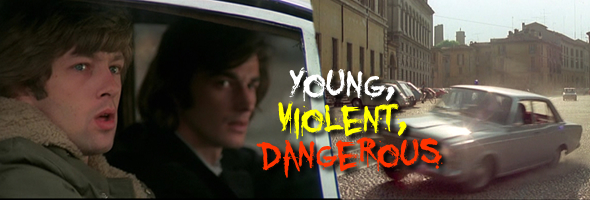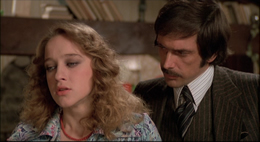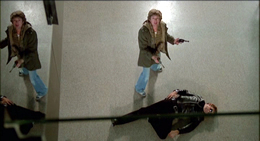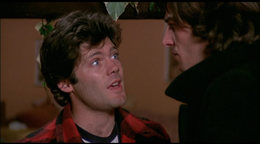
Color, 1976, 96m.
Directed by Romolo Guerrieri
Starring Stefano Patrizi, Eleonora Giorgi, Tomas Milian, Benjamin Lev, Max Delys, Venantino Venantini
Raro (US R0 NTSC, Italy R0 PAL) / WS (1.66:1) (16:9)

Color, 1976, 96m.
Directed by Romolo Guerrieri
Starring Stefano Patrizi, Eleonora Giorgi, Tomas Milian, Benjamin Lev, Max Delys, Venantino Venantini
Raro (US R0 NTSC, Italy R0 PAL) / WS (1.66:1) (16:9)
 Though promoted as another Italian crime thriller with genre staple Tomas Milian (Almost Human) as a gun-blasting cop, Young, Violent, Dangerous (original title: Liberi armati pericolosi) actually plays more like a ‘70s afterschool special hijacked by a band of renegade Italian guerilla filmmakers. Much like alarmist juvenile delinquent films from the previous decade like Just for the Hell of It, this violent offering casts a wary and sad eye on the reckless youth of today (well, 1976 anyway), who are suffering from a lack of parental guidance and finding thrills wherever they can.
Though promoted as another Italian crime thriller with genre staple Tomas Milian (Almost Human) as a gun-blasting cop, Young, Violent, Dangerous (original title: Liberi armati pericolosi) actually plays more like a ‘70s afterschool special hijacked by a band of renegade Italian guerilla filmmakers. Much like alarmist juvenile delinquent films from the previous decade like Just for the Hell of It, this violent offering casts a wary and sad eye on the reckless youth of today (well, 1976 anyway), who are suffering from a lack of parental guidance and finding thrills wherever they can.
The main troublemaker here is unstable rich kid Paul a.k.a. "Blondie," played by Stefano Patrizi (aka the Italian Andrew McCarthy), who had just had his first big role in Luchino Visconti’s Conversation Piece and would go on to Rome: Armed to the Teeth, Murder Obsession, and Lion of the Desert before switching to a career in advertising. He’s the de facto leader of a trio of Milanese joyriding kids including the more straitlaced pretty boy Louie (Delys) and hyper, wisecrac king Joe (Beware of a Holy Whore’s Lev). When they decide to hold up a gas station, Louie’s girlfriend, Lea (Inferno’s Giorgi), snitches to the cops. The investigating officer (Milian) tries to track the boys down as their escapades spiral into a bloody crime spree, knocking over a bank and then a grocery store (where they also plow down a quartet of other hooligans helping them out, after using them to get some ammunition and indulge in an improvised orgy where they break wind under the covers!). A visit to Lea forces them to take her along as an unwilling fourth passenger, leading to a heightened police pursuit that can’t possibly end well.
king Joe (Beware of a Holy Whore’s Lev). When they decide to hold up a gas station, Louie’s girlfriend, Lea (Inferno’s Giorgi), snitches to the cops. The investigating officer (Milian) tries to track the boys down as their escapades spiral into a bloody crime spree, knocking over a bank and then a grocery store (where they also plow down a quartet of other hooligans helping them out, after using them to get some ammunition and indulge in an improvised orgy where they break wind under the covers!). A visit to Lea forces them to take her along as an unwilling fourth passenger, leading to a heightened police pursuit that can’t possibly end well.
Though directed by Romolo Guerrieri (who genre hopped between such films as The Sweet Body of Deborah, Johnny Yuma, and Covert Action), this film is more noteworthy for one of its screenwriters, crime specialist Fernando Di Leo, working from a novel by Giorgio Scerbanenco (who also penned the sources for Caliber 9 and Naked Violence, among others). The Di Leo touch is certainly in evidence here, both in the high-octane heist and chase scenes and the weird interludes with the kids hanging out among their own and cutting up (which resemble some of the sequences in his most controversial film, To Be Twenty). Though Milian may be the star attraction here (looking a little sickly and bearing more than a passing resemblance to Sonny Bono!), it’s really the younger actors’ show all the way; Patrizi definitely has one of his stronger roles here, and the stunningly beautiful Giorgi (who had just appeared in the smoking hot Appassionata) easily commands attention in all of her scenes while showing some skin in the third act for good measure. Perhaps the weirdest ingredient is the score by Gianfranco Plenizio and Enrico Pieranunzi, which mixes poliziotteschi funk with a recurring soft ballad. Had Ray Lovelock played one of the bad teens, he no doubt would’ve been warbling that song over the opening credits, too.
 Raro first issued this title in Italy near the tail end of their run of Di Leo titles, with a colorful transfer that, like a few of their other random titles, was non-anamorphic. The US edition is essentially the same but better compressed than its predecessor, and it's still non-anamorphic (which will make viewing it with subtitles a bit frustrating for widescreen TV owners). On the other hand, the PAL speedup is corrected here as the film correctly runs 96 minutes versus the 92 of the Italian disc. The main video extra from the Italian release is carried over here, the mini-documentary “Ragazzi fuori,”
with Guerrieri talking in mainly conceptual terms about the film, talking about its deliberate avoidance of gratuitous violence, his views on the characters' lack of ideals or motivation, working with Di Leo, persuading Milian to return to an action filmmaking, and his intention to create a detective removed from the usual "fascist" perceptions of movie critics. Also included are a director filmography and biography; the menu indicates a DVD-Rom PDF containing an essay about the film, though it didn't show up in the two PCs sampled for this review.
Raro first issued this title in Italy near the tail end of their run of Di Leo titles, with a colorful transfer that, like a few of their other random titles, was non-anamorphic. The US edition is essentially the same but better compressed than its predecessor, and it's still non-anamorphic (which will make viewing it with subtitles a bit frustrating for widescreen TV owners). On the other hand, the PAL speedup is corrected here as the film correctly runs 96 minutes versus the 92 of the Italian disc. The main video extra from the Italian release is carried over here, the mini-documentary “Ragazzi fuori,”
with Guerrieri talking in mainly conceptual terms about the film, talking about its deliberate avoidance of gratuitous violence, his views on the characters' lack of ideals or motivation, working with Di Leo, persuading Milian to return to an action filmmaking, and his intention to create a detective removed from the usual "fascist" perceptions of movie critics. Also included are a director filmography and biography; the menu indicates a DVD-Rom PDF containing an essay about the film, though it didn't show up in the two PCs sampled for this review.
Most interestingly for the main feature, you get two very different audio options: the original Italian track (and yes, this one was most definitely shot in Italian) with optional (newly translated and more Americanized) English subtitles, or the English dub track. Several of the main character names are different (Paul/Blondie = Mario, Joe = Giovanni, Louie = Luigi), and almost all of the quips by Joe are completely rewritten; for example, a gag about Miracle in Milan on the Italian track instead refers to A Fistful of Dollars in the English dub when they’re flinging cash at clueless bystanders from their car windows. The Italian track also contains numerous additional lines of dialogue dropped entirely from the English one, and the two frequently don’t time up with each other at all when actor’s lips aren’t actually seen moving onscreen. In other words, go with the Italian version your first time around, then check it out again in English for a wholly separate experience. One recurring gag completely lost in both versions (and probably completely beyond the poor folks charged with making the subtitles) is Joe's habit of rattling off Italian crime movie titles as commentary on the action, such as calling one character La mala ordina (the original title of Almost Human) and at point exclaiming during a big car chase, "Milano violenta, la polizia non relenta!"
![]()